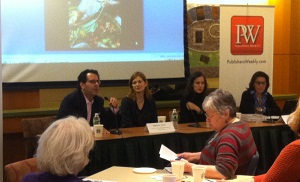Nov 19, 2012 - PW

From left: Mark Rotella, Melissa Clark, Amanda Hesser, Doris Cooper.
The digital changes facing cookbook publishers were at the forefront of the latest in the PW Discussion Series, “The Digital Kitchen: Adapting Cookbooks in the App Age,” held November 16 and hosted by Mark Rotella, editor of PW’s Cooking the Books newsletter. “Cookbooks used to be a one-way relationship,” said panelist Amanda Hesser, cofounder of Food52.com, a Web site that uses a community-based model for its recipes, which it has turned into two cookbooks (the second is due in December 2012) and two apps (priced at $3.99 each, which they settled on after much experimentation). When asked how Food52.com deals with crowdsourced content, relinquishing a measure of control, Hesser said, “There’s a certain level of trust,” but countered by saying that Food52.com’s staff views curation as a prime role, and that “if you open up the doors all the way, you turn into Allrecipes.com” (Hesser stated there are 20,000 recipes on Food52.com compared to the 200,000 on Allrecipes.com). Because of the increasing flow of cookbook and recipe information out there, Hesser said, people are looking for direction.
Doris Cooper, v-p and editorial director of Clarkson Potter and Potter Style, agreed with Hesser, and added that people go to cookbook apps to “solve problems,” using the example that if you have buttermilk in your fridge, you’re going to go to an app to find out how you can use it, rather than pick up a cookbook, which, Cooper said, is more of a reading experience. The divergent purposes of print vs. digital cookbooks kept coming up during the panel. Melissa Clark, author and staff writer for The New York Times, who both writes and does video for the Times, said she has a different audience for each medium. “I don’t want to do one without the other,” Clark said, noting that younger people tend to watch her cooking videos, while older cooks tend toward her print columns. With the doors that digital has opened, Clark noted, people now first seek a brand they like, and then find the form they like, whether it be online, through apps, or in print.
Positives, as well as uncertainties, are in the future of cookbooks in the digital age. For one, the cookbooks category has experienced 4% growth year-over-year since 2000, said Cooper, and the process of creating digital cookbook content is becoming more and more refined as content creators and publishers gain “muscle memory” from continuing to put out content. But there’s still somewhat of a disconnect between consumers and cookbook apps and e-books. For apps, many consumers are still hesitant to put a $399 iPad on the kitchen counter; for e-books, consumers are still having a difficult time understanding the difference between an e-book and an enhanced e-book, and, at Clarkson Potter, no cookbook e-book has outsold its print counterpart, Cooper noted.
No comments:
Post a Comment